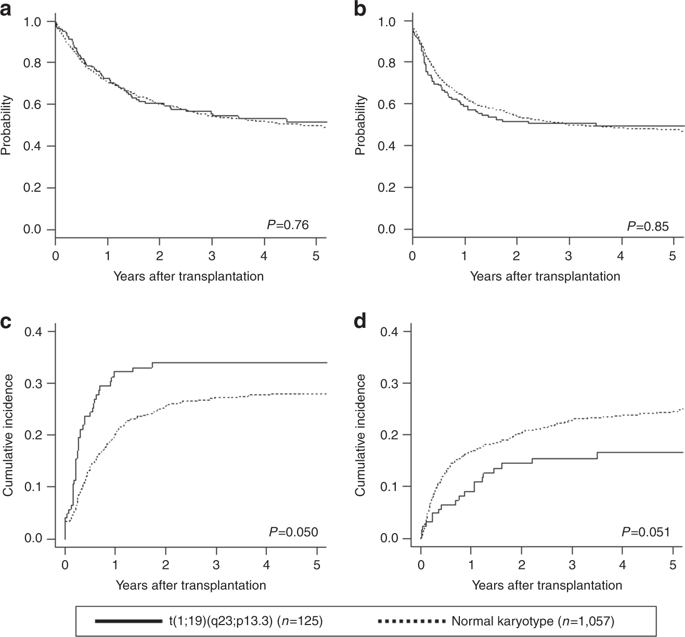Bone Marrow Transplantation ( IF 4.5 ) Pub Date : 2020-02-10 , DOI: 10.1038/s41409-020-0816-6 Satoshi Kaito 1 , Yuho Najima 1 , Kaito Harada 2 , Takahiro Fukuda 3 , Yuma Noguchi 1 , Kazuhiro Ikegame 4 , Masatsugu Tanaka 5 , Yukiyasu Ozawa 6 , Shuro Yoshida 7 , Masashi Sawa 8 , Shuichi Ota 9 , Yoshiko Inoue 10 , Junji Tanaka 11 , Tatsuo Ichinohe 12 , Yoshiko Atsuta 13, 14 , Shinichi Kako 15 ,

|
There are few reports on allogeneic hematopoietic stem cell transplantation (allo-HSCT) for adult B-cell acute lymphoblastic leukemia (B-ALL) harboring t(1;19)(q23;p13.3). We used nationwide registry data of Japan for 2003–2016 to evaluate transplant outcomes and clarified prognostic factors among adult allo-HSCT recipients with B-ALL harboring t(1;19)(q23;p13.3) (n = 125). Compared with cytogenetically normal (CN) B-ALL patients (n = 1057), their 3-year overall survival (OS) rates were comparable (55.4% for t(1;19) and 54.4% for CN; P = 0.76). Considering only patients in first complete hematological remission (CR1), the 3-year OS rates remained comparable (70.5% for t(1;19) and 67.8% for CN; P = 0.86). For t(1;19) patients in CR1, minimal residual disease (MRD) at transplantation was associated with relatively worse outcomes. The 3-year OS rates were 43.6% for patients with MRD and 77.4% for those without it (P = 0.016). The 3-year relapse rates were 54.5% for patients with MRD and 12.8% for those without it (P < 0.001). Multivariate analyses revealed that MRD at transplantation was a significant risk factor for OS and relapse. In the high-intensity chemotherapy era, t(1;19)(q23;p13.3) did not have a poorer posttransplant prognosis than the normal karyotype. However, even for patients in CR1, MRD at transplantation was associated with comparatively worse OS and higher relapse rates.
中文翻译:

携带 t(1;19)(q23;p13.3) 的成年 B 细胞急性淋巴细胞白血病患者的异基因造血干细胞移植;与正常核型比较
关于携带 t(1;19)(q23;p13.3) 的成人 B 细胞急性淋巴细胞白血病 (B-ALL) 的异基因造血干细胞移植 (allo-HSCT) 的报道很少。我们使用日本 2003-2016 年的全国登记数据来评估移植结果并阐明 B-ALL 携带 t(1;19)(q23;p13.3) ( n = 125)的成年 allo-HSCT 受者的预后因素。与细胞遗传学正常 (CN) B-ALL 患者 ( n = 1057) 相比,他们的 3 年总生存率 (OS) 相当(t(1;19) 为 55.4%,CN 为 54.4%;P = 0.76)。仅考虑首次完全血液学缓解 (CR1) 的患者,3 年 OS 率保持可比性(t(1;19) 为 70.5%,CN 为 67.8%;P = 0.86)。对于 CR1 的 t(1;19) 患者,移植时的微小残留病 (MRD) 与相对较差的结果相关。MRD 患者的 3 年 OS 率为 43.6%,非 MRD 患者为 77.4%(P = 0.016)。MRD 患者的 3 年复发率为 54.5%,非 MRD 患者为 12.8%(P < 0.001)。多变量分析显示移植时的 MRD 是 OS 和复发的重要危险因素。在高强度化疗时代,t(1;19)(q23;p13.3) 的移植后预后并不比正常核型差。然而,即使对于 CR1 患者,移植时的 MRD 与相对较差的 OS 和较高的复发率相关。











































 京公网安备 11010802027423号
京公网安备 11010802027423号